 For quite some time I’ve been curious to know, “what’s the best way to transfer designs from paper to fabric for embroidery?” And “what’s the easiest way to that doesn’t use iron on transfers?” These are pretty simple questions I’m sure, but as a novice embroidery, the answers have defied me. I’ve looked up a lot of techniques before, but never really tried that many of them to know for myself how they work.
For quite some time I’ve been curious to know, “what’s the best way to transfer designs from paper to fabric for embroidery?” And “what’s the easiest way to that doesn’t use iron on transfers?” These are pretty simple questions I’m sure, but as a novice embroidery, the answers have defied me. I’ve looked up a lot of techniques before, but never really tried that many of them to know for myself how they work.
Well, today that ends. I spent the whole morning looking up and transferring different designs to see how it worked out.
Here is what I tried, how it worked, and more methods that would be worth looking into that I found:
1. DIY Carbon Paper Transfer – Using the idea of transfer paper, I made my own with a charcoal pencil. It’s a bit messy, but if your work can be rinsed off afterwards, this could work out. It’s a bit messy for me though. It was worth a shot!

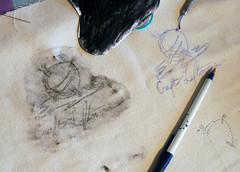
2. Carbon Paper Transfer – I read about this on Pimp Stitch and then realized, hey, this is how everyone is doing it. And with good reason too! It’s fairly cheap, it transfers well, it’s not messy, and you can use just about any drawing from anywhere. I would, especially if it was a design I purchased and not just something I printed out from a pdf, trace it onto tracing paper and then transfer it with the carbon paper. Just because over time, the pencil that you are using to transfer the carbon will rip up the paper.
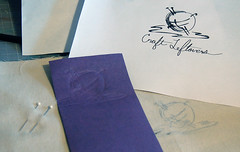

3. Prick and Pounce DIY – I don’t have pounce, so I tried an alternate version of this traditional transfer method. I pricked the design and then “pounced it” by going through each hole with a fine tip sharpie (I don’t have a good sewing pen at this point, which is what I would recommend instead). It actually worked pretty well, just a little time consuming.
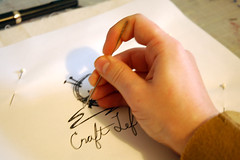
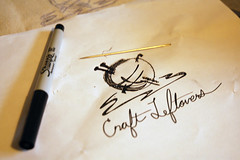
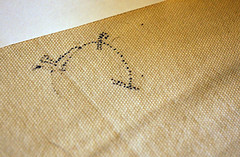
4. Prick and Pounce DIY Variation #2– Well, I didn’t have any vellum on hand either and when I tried using just the print out is just didn’t work. So I tried wax paper. And then because of the lack of the pounce (powdered charcoal for black, powdered cuttlefish for white) I used my charcoal pencil. It worked, but it shifted too much because the wax paper was too thin and the friction of the charcoal pencil. I think that if you have vellum and some powdered charcoal, this would be great. I read that often artists would paint in the lines and now it’s common practice to pencil them so they are slightly more permanent. Also, if you are working with a larger design, it’s suggested that you work 2″X2″ sections at a time and line up new sections with the pencil marks of the previous section.
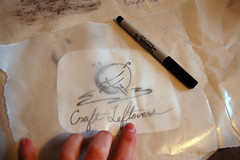
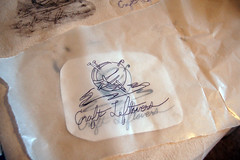
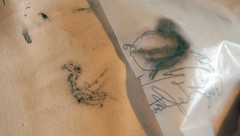

Other recommended methods:
Tissue paper transfer – Simply trace your design onto a piece of tracing paper or tissue paper, pin it to your fabric, and embroider away. Once finished, the tissue paper should tear away easily.
Transfer pencil/pen – it’s highly recommended by several people, including Floresita of Things I’ve Made, who shows you how it works. I’m going to have to get my hands on one and give it a try for myself. It looks like it works really well.
Light box (window) – With lighter weight fabrics, you can place the design under the fabric, tape it to a light box (or your window) and trace it directly onto the fabric. I bet this would work really well. Oh and over at tipnut.com they let us know to use a soft pencil so the fabric doesn’t snag or shift.
So what’s your favorite transfer method for embroidery designs?
Do you want to show your pride in using up your stash? Embroider your own Craft Leftovers patch!
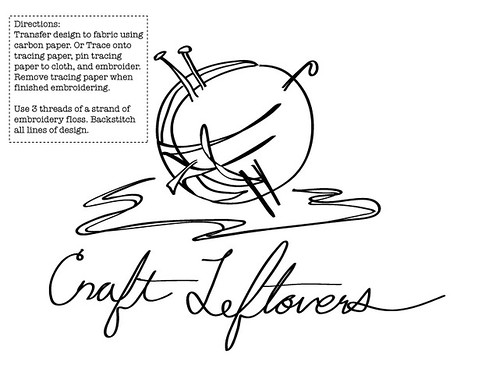
+++++++++++++++++++++++
Sources for this How To:
Pimp Stitch – check out this cute tutorial on their blog for adding fabric to your embroidery (wouldn’t the cl yarn ball look cute as a piece of wool felt? I think so!)
Royal School of Embroidery Techniques – Google Books
+++++++++++++++++++++++
I think that learning how to transfer embroidery patterns from drawings is a huge break through for me. I’m really looking forward to using my drawing skills to make lots of fun, quick craft leftover embroidery projects. An issue I’ve been having for a long time is the over coloring. My strongest embroidery (that I’ve done for myself) are when I just draw on the cloth and back stitch or split stitch over the line drawing. So why didn’t I look this info up ages ago? Who knows! But I have now and I’m pretty happy about it.
+++++++++++++++++++++++
In other news I just printed out the zine’s new template/layout and it looks pretty sweet. I’m happy to say that I’m switching to paper/cardstock that is partially post consumer recycled paper. A good step in the right direction for craft leftovers. I also am making the switch to recycled paper for all the patterns/tag/etc for the kits and handmade goodies in the shop. I’m still looking for a good source for 100% recycled or alternative paper (like hemp) card stock/paper. If you have any ideas where to look, I would love your help on this, it’s really important to me.
And in other news, Craft Leftovers Monthly will be going up in the shop on Sunday morning. I’ll have a preview ready for you tomorrow afternoon, so check back for that. I’ll post on Sunday too to remind you that it’s up. I’m switching it back to etsy too, pretty much for the same reason I move the shop there. And there will be a “buy one, get one as a gift for your craft buddy 20% off” sale in the season of holiday giving. And, lots of ands in here haha, I’m going back to offering a limited amount of new subscriptions each month, so there will only be 15 going into the shop for the Holiday issue.
Oh and one more thing. Jason and his friend have been working on this game called X Marks the Not and it’s pretty fun, and there is a mix of music that plays and it’s become a nice little distraction for me (and the interface is pirate themed and I like that). It’s a find what’s different game, which I’ve always been a sucker for since I was a kid, and it’s actually pretty hard! A lot of times I can only find like 4 of 5 before time is up. Oh and the really cool thing is that it’s tied into IndieCrawler so the music that plays is from indie bands! There isn’t a ton of music in rotation yet, so there are some poppy songs, but that will change soon. So if you like music, go play the game, if you are a musician, you should go sign up for IndieCrawler and have some great tools for selling your music, you can read about it here.
And on that note, I’m going to play another round of X Marks the Not, eat dinner, and start working on clm again. It’s a good day to be crafty and playing games, it’s so dark and rainy outside.
Have a good day and happy crafting!
Kristin
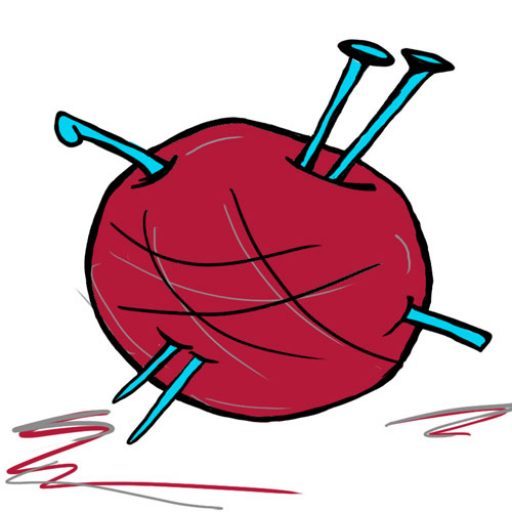
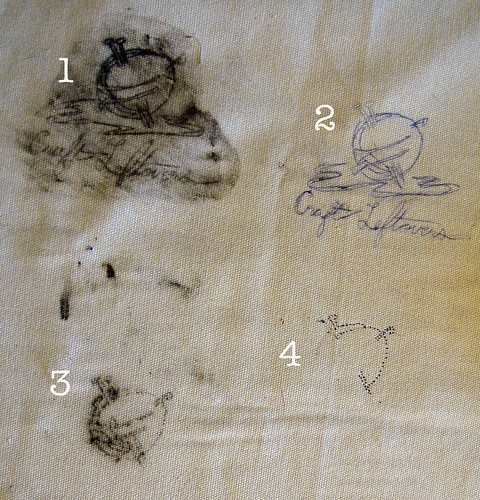
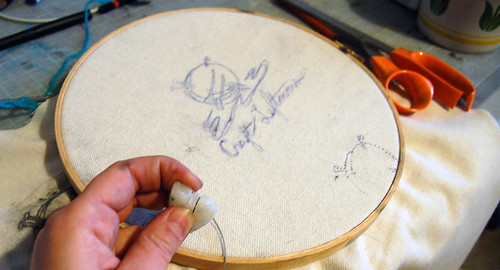
Hoorah for embroidery breakthroughs! :)
I love the carbon paper method for all the reasons you describe – it’s clean, clear, inexpensive, etc. I’ve even found new transfer paper that claims to wash out, which *really* makes me happy. And the carbon paper can be used over and over and over again. The main sheet I use was in my grandmother’s sewing basket that she gave to me. I love it, because I can see all the images I’ve transferred. It’s sort of an interesting chronicle of my projects!
The lightbox method is also nice.
Love the pattern, and I love seeing you explore embroidery! Enjoy! :)
XO
Rach
Thanks for the tips for transfering designs onto fabric. One method that I started out with was using a graphite pencil (B or 2B) and tracing the design on the backside of the paper or even coloring in the entire design area on the back then putting it down on the fabric and tracing the design. It worked great and I didn’t have any problem with smuding. Of course at Michaels, they sell graphite paper but it is almost free to do it yourself.
I also have a red transfer pencil that irons on after you trace your design with it. It works fairly good as long as you get your lines dark enough with the pencil.
I’m looking forward to the new Craft Leftovers kit you have coming out, I am counting down until Sunday when I can get one of your kits. :)
I used to use a red transfer pencil and then iron on the design, but the lines would be wide, even with sharpening the pencil, and I didn’t always want to use six strands of floss to cover it. Now, I tape the design to the window and trace it with a pencil. I have some carbon paper and really should try that method next.
For myself, I love the lightbox (actually read-tape to window and trace). I have a few of my girls drawings that I’ve done that way. Just never got around to actually embroidering them.
Thank you so much for taking the time to show us this. It was really informative and I would have to say other than the lightbox, I would be interested in the prick and pounce method.
Oh, and thank you for the free pattern!
I bookmarked “X Marks the Not”. So addictive.
I’ve used the carbon paper and the blue water soluble pens… the problem with the blue wash out pens is that if you don’t REEEALLY wash it, it can leave a yellow stain that looks gross and makes the fabric look dirty. I’ve been experimenting with washing fabric after using it, but it’s worth knowing… If you had a pattern on your computer you could print the pattern directly onto fabric. Don’t go buy the stuff though (TOO EXPENSIVE!) just iron on the plastic backed freezer paper (plastic side to the fabric), and cut it down to fit your printer. Super cheap and it works!
great tutorial! it was very informative, as i am new to embroidering and was completely confuzzeled as to how to get my images to transfer. i think i’d like to use the transfer pencil method :) thanks!
i tried lots of other methods, but my current favorite is using glad press ‘n seal plastic wrap. just trace your design using a sharpie and stick it on your fabric — it makes great stabilizer, too.
I’ve had all these same questions! Thanks for the info. I have tried holding it up to the window and tracing with mediocre results. I’ve tried tracing the design onto wax paper, then pinning it to my fabric, stitching thru the wax paper, then tearing it off. It was shifty and usually started tearing by the time I finished. I think the press n seal idea is GENIUS! I also want to try the carbon paper.
“Of course at Michaels, they sell graphite paper but it is almost free to do it yourself.”
Nooope… Michaels no longer carries it.
:::smacking forehead::: Press & Seal waxed paper, how genius, how obvious once it’s pointed out. Great idea!
Thanks, that was really helpful! I’ve just started embroidering over the past 2 weeks and now that I feel comfy with the stitching I’m trying to figure out how to go about transferring designs. Your post was very clear, and I think I’m going to try out the carbon paper method. Thanks again for the tips!
Another method is to use a really thin pigma permanent marker size 005 in the color that you will be stitching. Use a lightbox or hold your fabric up to the window with the design beneath and trace the design onto your fabric. Then just stitch right over the line.